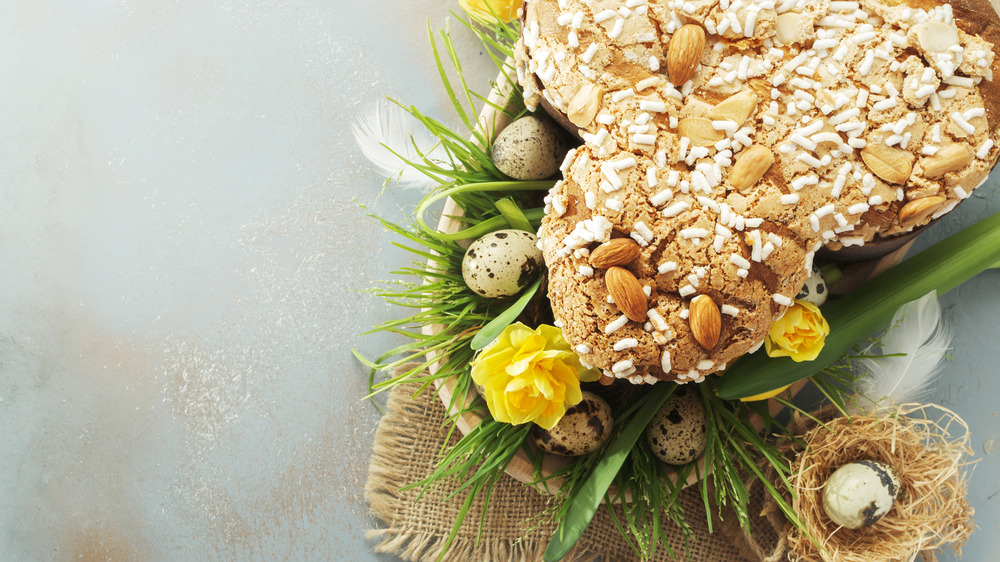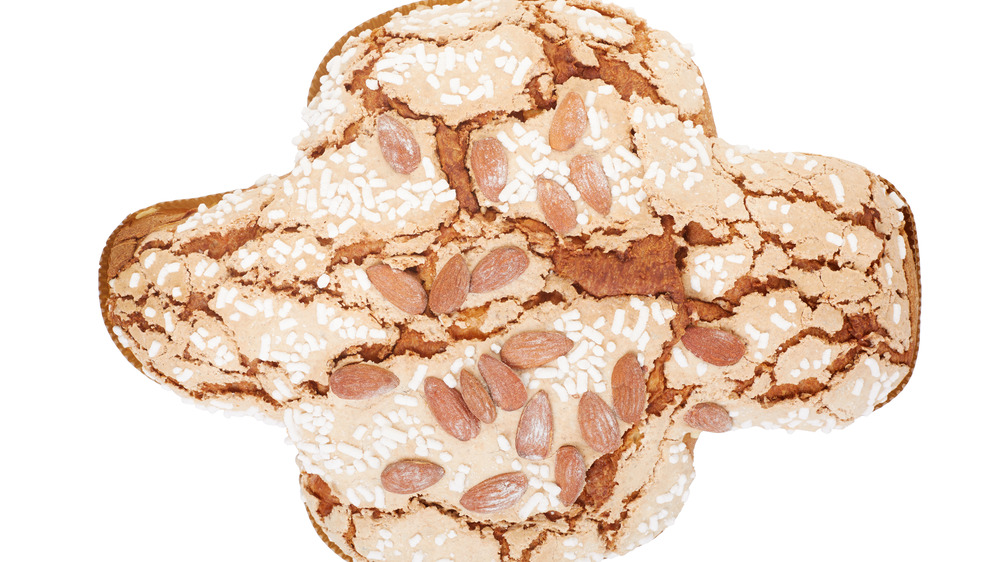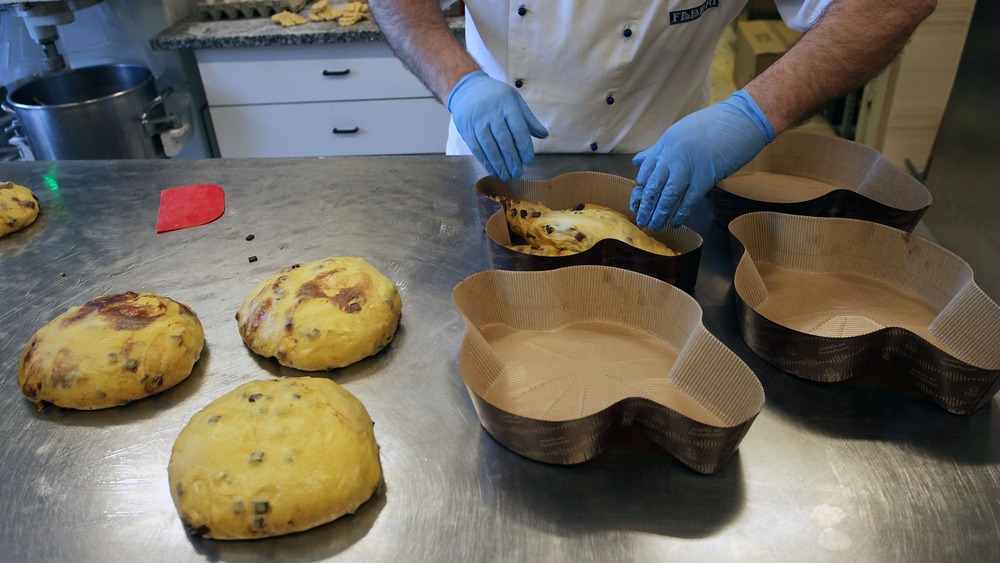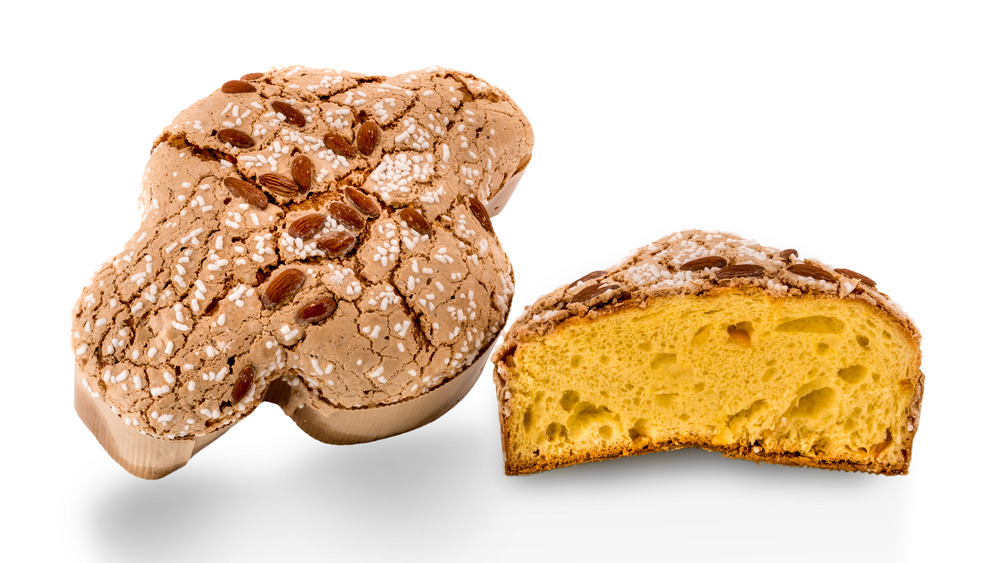Everything You Need To Know About Italian Easter Cake
The Italians sure do love their holidays. Christmas is huge, of course, as is La Festa di San Giuseppe, and every single village and parish has its own festival-worthy saint, as well. Carnevale is celebrated throughout the country, although the Venetian version may be the one most tourists come to see. One of the biggest holidays in this Catholic country, however, is Easter. Pilgrims throng the streets of Rome throughout Holy Week, and the rest of the country gets its share of visitors, too. If you want to have a buona Pasqua in Italia, it'll likely cost big bucks — as Walks of Italy points out, it's one of the most expensive times of year to visit.
Fortunately, if there's one thing Italy is known for exporting besides wine, fashion, and sports cars, it's Italians. The Italian diaspora is spread across the United States, and wherever Italians go, they bring their delicious food traditions with them. Must-try Easter treats available at Italian bakeries include many variants on the colorful egg-bedecked Italian Easter bread, a rice-filled pizza rustica, and a sweet rice-ricotta pie the Italian Tribune says is the typical Easter Sunday dessert. (There's also a variant made with wheat that's more typically served on Holy Thursday.) So many pies, so many breads ... but what about cake? Well, sort of. Colomba di Pasqua is really a sweet yeast bread, but both Eataly and Bon Appetit say it could be considered sort of cake-ish, as well.
Colomba di Pasqua could be one of Italy's oldest Easter treats
According to several legends retold by Oregon Live, colomba di Pasqua may date back to medieval Lombardy. The earliest origin story involves the sixth-century Siege of Pavia, something the Pavians came out on the wrong end of in 572. The conquering king, one Alboin (not a typo) by name, demanded the usual tribute of a dozen "nubile maidens." While 11 of them submitted to their fate as the newest recruits to the royal harem, the 12th decided to sweet-talk, or rather sweet-bake, her way out of the deal by gifting the king with a bread (or cake) shaped like a dove. He not only freed her but spared the city from destruction, so it must have been some pretty darn good bread (or cake).
A less racy origin story takes place some six centuries later in 1176. At this time, the bread was said to have been baked to celebrate the Lombards' victory over the Holy Roman Emperor Barbarossa (no relation to Captain Barbarossa of Pirates of the Caribbean fame). Evidently, two doves had appeared during the battle and perched atop the Lombards' standards. As they subsequently won the battle, they chose to interpret this as a miraculous manifestation of the Holy Ghost rather than grumbling, "Oh great, now we're going to have to clean bird poop off our banners," so celebratory baking ensued.
Colomba di Pasqua is too complicated for most home cooks
Colomba di Pasqua, as Bon Appetit describes it, is somewhat similar in taste and texture to the more familiar Christmas panettone, although it has the advantage of being raisin-free. The fruit used in this springtime bread is more likely to be candied orange peel, although it seems this is optional. Other regional additions may include Amarena cherries in Emilia-Romagna and hazelnuts in Piemonte, and some bakers even mix chocolate chunks or other embellishments into their dough.
Eataly notes that the main ingredients are simple enough: flour, sugar, butter, eggs, and yeast. The type of yeast traditionally used, however, is an all-natural one that must be exceptionally slow-acting, since the dough needs at least 30(!) hours to rise. That's fitting, perhaps, since it did take Christ three days to rise from the tomb, and Easter foods are nothing if not symbolic. After the bread has finally risen, it's then shaped into something vaguely resembling a dove, baked, and sprinkled with a topping of pearl sugar and almonds. According to The Spruce Eats, many of these dove-shaped breads are also adorned with colored, hard-boiled eggs, making them essentially a shaped variant of the standard Italian Easter egg bread (which is itself also sweet rather than savory).While Italians pride themselves on their cooking skills, even the most traditional will tend to default to a store-bought version of the labor-intensive colomba di Pasqua, as is the case with panettone as well.
How colomba di Pasqua is served
This not-too-sweet Italian Easter cake/bread makes a great breakfast, of course, along with a tiny cup of espresso. If you want to make the bread more dessert-like, you can always slather it with honey, jelly, jam, or maybe Nutella (which is, after all, an Italian creation), top it with whipped cream, and/or drizzle it with chocolate sauce. You could also use it as the basis for a fantastic French toast or bread pudding.
Another thing you can do with this not-quite-cake is to lean into its less sweet side by toasting slices of it and serving these alongside a selection of cheeses. Kowalski's Market has another sweet/savory suggestion for serving panettone that would work equally well with colomba di Pasqua: slather the toasted bread with mascarpone and then top the cheese with chopped figs, rosemary, and honey. Eataly offers yet another way to enjoy colomba di Pasqua: paired with a glass of dessert wine or prosecco for an afternoon or evening pick-me-up. Just the thing after a hard day spent hunting Easter eggs!



